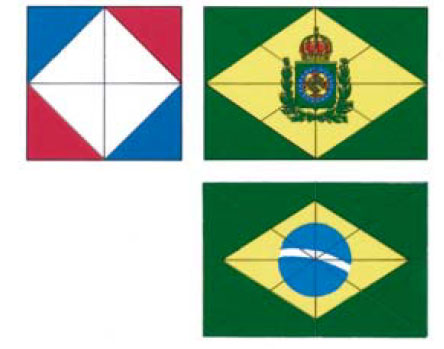It is evident that the Flag of Brazil, that is, essentially, the same since independence, is an undisputable copy of the Italian Napoleonic kingdoms and republics:
https://en.wikipedia.org/wiki/Kingdom_of_Italy_(Napoleonic)
https://pt.wikipedia.org/wiki/Ficheiro:Flag_of_the_Kingdom_of_Naples_(1808).svg
http://internationalcongressesofvexillology-proceedingsandreports.yolasite.com/resources/20th-Stockholm/ICV20%20Breschi.pdf
The author of the Brazilian flag was a Frenchman Jean Baptiste Debret who served Napoleon, so the link is reinforced.
However, the lozenge, or rhombus of the Brazil and Italian Napoleonic flags are preceded by the Napoleonic Italian Republic that used a square flag with a rhombus/lozenge that is, essentially, a 45º angle square and a copy of the Napoleonic regimental flags that were used by the army since the 1794 reform, before Napoleon (made universal for the whole army in 1803):
https://www.crwflags.com/fotw/flags/fr%5Er_rv.html
http://tmg110.tripod.com/frarmy4.htm
The elongated form of the inclined square, or rhombus/lozenge, is the result of the adaptation to a rectangular flag, instead of a square: the maritime flag of the Napoleonic Italian Republic is the first historical example of a rhombus/lozenge adapted to the rectangular flag.
It is evident that the French Revolutionaries adopted the Lozenge/rhombus in the beginnings for the army banners, it is also evident that the same form was widely used in Napoleonic Italy being adapted from the banner to the flag (rectangular); and it is also evident that Brazil copied the same form.
But why? It was always my conviction that the common element in all this history was Freemasonry: the founders of Brazil were Freemasons (D. Pedro and José Bonifácio); Napoleon, his older brother Joseph and Beauharnais were Freemasons and were in charge of Napoleonic Italy; the author of the flag was a Freemason; and, recently, the last Italian President approved a new presidential banner that is a copy of the Napoleonic Italian Republic, also a Freemason; is also well known the Freemasonry influence and participation in the French Revolution.
Is evident the existence of some kind of connection between the banner and Freemasons; but why? what is the relation between the rhombus/lozenge and Freemasonry? It is not a common, or well-known masonic symbol; it is also well-known that Freemasonry plagiarized several existent symbols: many from Christianity and Jewish Kabbalah.
It is possible that the institution of the lozenge in army banners in 1794 was an aesthetic choice (it would be necessary to read the sessions of the approval of those banners); however, it can't be coincidental the affinity of so many Freemasons with the symbol. A lozenge/rhombus is nothing more than two triangles connected; and I can find 6 reasons for its use by Freemasons:
1st - the inner space between the square and compass, is a "diamond";
2nd - Robert Fludd's Created Universe, is a "diamond";
3rd - the Star of David are two triangles and create a "diamond";
4th - As above, so below symbolic representation, create a "diamond";
5th - Aristotelian elements and qualities;
6th - the Diamond is the perfection of an imperfect stone after chiselling.
Is almost impossible to say, for sure, that is a symbol created by Freemasons, but something is undisputable: the connection of the symbol with Revolutionary Principles and Freemasons affinity to the geometric form of the "diamond".
I can not find any personal information, or if was Freemason or not, about the designer of the French Regimental Banners and many Napoleonic flags, but I found it was Jean-Baptiste Challiot de Prusse and designed this:
https://art.rmngp.fr/fr/library/artworks/jean-baptiste-challiot_modele-de-drapeau-pour-le-1er-bataillon-d-eclaireurs_mine-de-plomb_papier_gouache_rehauts-d-or_1803
My source of Chailliot (or Chaillot, or Challiot) and states that he design many of the Republic and Empire flags (drapeaux): https://gallica.bnf.fr/ark:/12148/bpt6k320049v/f113.item.r=%22chailliot%20de%20prusse%22
PS: I reiterate: I can't say for sure that the design is a Freemason design, I only notice that Freemasons like the design. I mention Freemasonry because is a Guild that uses many symbols. However, despite this connection, other can be asserted, the Revolutionary Ideals dispersed throw Europe by Napoleon.
And, this website is in English so, some English Freemason that read this may find it strange but, Anglo-Saxon Freemasonry is different of French Freemasonry that spread to Catholic countries.
I give an example: despite the British brought Freemasonry to Portugal, and its ideals, soon the Portuguese Freemasons adhered to the French "version" of Freemasonry, that was strongly anti-Catholic, so much so, that General Beresford (British General commanding the Portuguese Army during Napoleonic Wars) condemn to death several Portuguese Freemasons when they adhere to that "French version" and turn on the British.
A new information, recently found: In 1821, in the Constituent Cortes of 1820 (one year before Brazil independance), the congressmen Manuel Gonçalves de Miranda proposed, as the new Portuguese Nacional Colours, the GREEN and YELLOW, but the proposal was dismissed on the grounds that those were masonic colours and the historical Blue and White was chosen instead. I could not find why green and yellow were considered, by the Congress, as "masonic colours", but this was the reason the proposal was dissmissed. This site didn't allow me to post the links with the information.
And after some research (unfortunatlly the site dont allow me to write the links) I found that the Lozenge is the "Jewel" used in the 16th degree, that is connected to the 15th degree of the Scottish Rite, together they form the "Council of the Prince of Jerusalem" and, althought the lozenge is more connected to the 16th degree its used to represent the "Prince of Jerusalem" degrees combined. What was very interesting is the symbolism of these degrees and the context. But the colours also were very interesting: the collar/ribon is green in the 15th and yellow in the 16th, so the aprons according to Hutchens.



